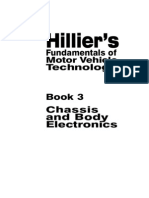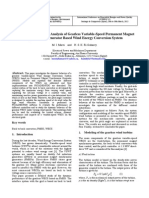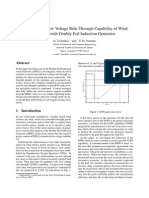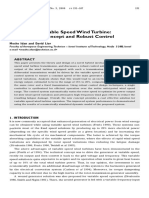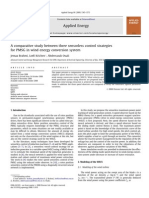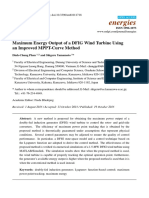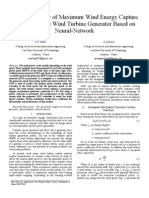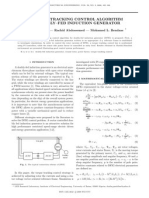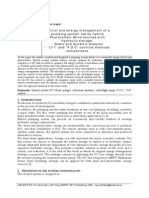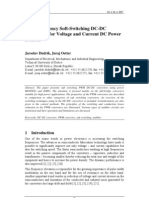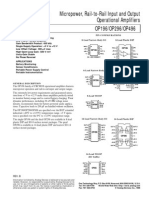Study and Control of A Variable-Speed Wind-Energy System Connected To The Grid
Study and Control of A Variable-Speed Wind-Energy System Connected To The Grid
Uploaded by
hassenbbCopyright:
Available Formats
Study and Control of A Variable-Speed Wind-Energy System Connected To The Grid
Study and Control of A Variable-Speed Wind-Energy System Connected To The Grid
Uploaded by
hassenbbOriginal Title
Copyright
Available Formats
Share this document
Did you find this document useful?
Is this content inappropriate?
Copyright:
Available Formats
Study and Control of A Variable-Speed Wind-Energy System Connected To The Grid
Study and Control of A Variable-Speed Wind-Energy System Connected To The Grid
Uploaded by
hassenbbCopyright:
Available Formats
International Journal OI Renewable Energy Research, IJRER
M.Mansour, M.N.Mansouri, M.F.Mmimouni, Jol.1, No.2, pp.96-104 ,2011
Study and Control of a Variable-Speed Wind-
Energy System Connected to the Grid
Mohamed Mansour
, M. N. Mansouri , M.F. Mmimouni
National Engineering School oI Monastir , Electrical Engineering Department, 5019 Monastir Tunisia
Mohamed MANSOUR; Address : National Engineering School oI Monastir, 5019 Monastir Tunisia,
Tel: (216) 73 500 511, Fax: (216) 73 500 514, e-mail: med.mansouryahoo.Ir
Received.15.04.2011 Accepted.17.05.2011
Abstract- Wind energy is a prominent area oI application oI variable-speed generators operating on the constant grid
Irequency. This paper describes the operation and control oI one oI these variable-speed wind generators : the direct driven
permanent magnet synchronous generator (PMSG). This generator is connected to the grid by means oI an IGBT rectiIier, a
DC bus, an IGBT inverter and a Iilter. The modelling oI the converters is made by using the concept oI instantaneous average
value. We have used an aleatory proIile oI wind speed in order to illustrate the diIIerent controls realized, especially with
maximum power point tracking algorithm (MPPT) and Pitch control at wind turbine level. To control the voltage oI the
continuous bus and the exchanges oI active and reactive powers, we have used proportional integral correctors. The simulation
results under Matlab\Simulink obtained and commented in order to validate the control strategy adopted.
Keywords- Variable-speed wind turbine, MPPT, Pitch control, PMSG, Control, Grid.
1. Introduction
Nowadays, the extraction oI power Irom wind
at a large scale became a well recognized
industry. This Iast development oI the wind
power industry was possible due to several
reasons, like: the increasing resistance regarding
the use oI coal, oil or uranium, the high price oI
oil and the climate change problem. By the end
oI 2008, the world total installed capacity oI
wind turbines reached 122 GW and it is
predicted that will exceed 300 GW by the year
2013 |1|.
Because oI the rapid development oI power
electronic devices and thus decreasing
equipment costs, the variable speed wind turbine
concept with Iull-scale Irequency converter has
an increasing market share. The most common
generators used in this topology, the doubly Ied
induction generators (DFIGs) and permanent
magnet synchronous generators (PMSGs), allow
the extraction oI maximum power Irom a large
wind speed interval. |2|,
The PMSG with a high pole number Ior low
speed, are also used in order to avoid having a
mechanical gearbox. It has some valuable
advantages over the DFIG such as : better
eIIiciency, easier controllability, no need Ior
reactive magnetizing current and they are
smaller in size.
The PMSG wind turbine, in general, is
connected to the power grid using a Iull-size,
properly controlled Irequency converter
technology. Two types oI converter topologies
are available these days. One, in which, the
Irequency converter is composed oI a diode-
rectiIier, DC-chopper, DC bus, and DC/AC
inverter. In the other topology, the Irequency
converter is composed oI an IGBT-rectiIier, DC
bus, and DC/AC inverter.
International Journal OI Renewable Energy Research, IJRER
M.Mansour, M.N.Mansouri, M.F.Mmimouni, Jol.1, No.2, pp.96-104 ,2011
97
udc
i
1
i
2
Wind
C
(R,L)
G
r
i
d
Wind turbine
PMSG
Rectifier DC bus Inverter Filter
Fig. 1. ConIiguration oI a PMSG wind turbine
In |3|, the control oI a variable-speed
permanent-magnet generator with a diode-
rectiIier Iollowed by a dc chopper is shown. With
this conIiguration the control oI the generator
power Iactor is not possible, which in turn,
aIIects generator eIIiciency. Also, high harmonic
distortion currents are obtained in the generator
that reduce eIIiciency and produce torque
oscillations.
This paper describes the modelling and control
system oI a direct-drive variable-speed
permanent-magnet generator with an IGBT-
rectiIier, connected to the grid. The presented
topology is subjected to a number oI control
schemes : Pitch angle control Ior limiting the
output power above rated values, MPPT
(Maximum Power Point Tracking) control Ior
extracting oI the maximum power and grid side
inverter control Ior active, reactive power Ilow
control, and constant DC bus control.
The proposed global model can easily be
simulated with the help a soItware like Matlab-
SIMULINK. Simulations are carried out by
considering a 750 kW wind generator.
The conIiguration oI the studied generation
system in this paper is represented in Fig 1
2. Wind turbine
2.1. Wind turbine modelling
The aerodynamic power at the rotor oI the
turbine is given by the Iollowing equation :
2 3
1
( , )
2
t t p
P R v C r p l b = (1)
where (kg.m
-3
) is the air density, R
t
(m) is the
turbine radius, v (m.s
-1
) is the wind speed and
C
p
(,) is the power coeIIicient which represents
the aerodynamic eIIiciency oI the turbine and
also depends on speed ratio and the pitch angle
.
The speed ratio , is given by :
t t
R
v
l
W
=
(2)
t
is the mechanical turbine speed (rad/s).
The mechanical torque produced by the turbine is
expressed as Iollows |4| :
3 2
1
( , )
2
t e m
C R v C r p l b =
(3)
C
m
(,) is the torque coeIIicient :
( , )
( , )
p
m
C
C
l b
l b
l
=
(4)
For diIIerent values oI , the C
p
(,) curves are
shown in Fig.2.
0 2 4 6 8 10 12 14 16 18
0
0 .1
0 .2
0 .3
0 .4
0 .5
P
o
w
e
r
c
o
e
f
f
i
c
i
e
n
t
C
p
Speed ratio
Beta=-2
Beta=0
Beta=2
Beta=3
Beta=5
Beta=10
Speed
ratio-opt
Cp-max
Fig. 2. Power coeIIicient characteristic versus speed ratio
and pitch angle
International Journal OI Renewable Energy Research, IJRER
M.Mansour, M.N.Mansouri, M.F.Mmimouni, Jol.1, No.2, pp.96-104 ,2011
98
We note the existence oI the maximal value oI
power coeIIicient C
pmax
corresponding to the
optimal value oI the speed ratio
optimal
Ior each
value oI pitch angle . The maximum value oI C
p
,
that is C
pmax
0.44, is achieved Ior -2 and Ior
5. This particular value
opt
results in the point
oI optimal eIIiciency where the maximum power
is captured Irom wind by the wind turbine.
2.2. Mechanical shaft modeling
The evolution oI the mechanical speed oI the
synchronous generator can be easily determined
using the dynamic equation. The simpliIied
model oI this equation is given by:
t
T t em t s
d
J C C f C
dt
W
= - - W -
(5)
where J
T
(kg.m
2
) is the total inertia which
appears on the shaIt oI the generator,
t
(rad/s) is
the turbine speed, C
t
(N.m) is the mechanical
torque, C
em
(N.m) is the electromagnetic torque,
C
s
(N.m) is the dry Iriction torque and f
(N.m.s.rad
-1
) is a viscous Iriction coeIIicient.
2.3. Pitch angle control
The pitch control is an essential method Ior
controlling the rotational speed oI wind turbine.
It activates when the rotor speed exceeds the
maximum rotor speed oI turbine
tn
, by giving
the order to increase the pitch angle to reduce the
turbine torque C
t
. The Fig 3 shows the speed
limit.
0 5 10 15 20 25 3 0
-4
-2
0
2
4
6
8
10
12
R
e
f
e
r
e
n
c
e
P
i
t
c
h
a
n
g
l
e
(
)
Turbine speed (rpm)
Fig. 3. ReIerence Pitch angle
For variable-speed wind turbines, a mechanical
actuator is usually employed to change the pitch
angle oI the blades in order to reduce power
coeIIicient C
p
and maintain the power at its rated
value. This speed actuator is an actuator
proportional presenting a not linearity. The
torque has been supposed proportional to
rotational speed oI the turbine by linearization oI
the model to order 1 |4-6|. The control strategy
implemented is as Iollows :
0
0
2 Ior 0
( ) Ior ~
ref t tn
ref t tn t tn
b b
b
b b
= = - W W
D
= W -W + W W
DW
(6)
with 0 () is the initial pitch angle (optimal
value) and tn (rad/s) is the Nominal mechanical
turbine speed.
AIter, to take into account the orientation
system oI the blades which can be oI type
hydraulic or electric, we introduce a transIer
Iunction oI the Iirst order. The purpose oI this
system is to control the position oI the blades
according to a reIerence.
1
1
ref
b
s
b b
t
=
+
(7)
s is the Laplace operator and b is the time-
constant oI the orientation system oI the blades.
Fig.4 shows the block diagram oI the Pitch
angle control system implanted in the simulation
soItware Matlab-Simulink.
1
(1 )
b
s t +
( )
3
1/2
t
R r p
l
( ) ,
m
C f l b =
t
W
( )
t
f b = W
Fig. 4. Scheme oI the implemented pitch control method
3. Permanent-Magnetic Synchronous
Generator (PMSG)
3.1. Modelling
The model generally used oI the PMSG is the
Park model. By considering only the Iundamental
harmonic oI the Ilux distribution in the air-gap oI
the machine and by neglecting the homopolar
component, the theory oI the space vector gives
International Journal OI Renewable Energy Research, IJRER
M.Mansour, M.N.Mansouri, M.F.Mmimouni, Jol.1, No.2, pp.96-104 ,2011
99
the dynamic equations oI the stator currents as
Iollows :
( )
( )
1
1
sd
sd s sd s t sq
s
sq
sq s sq s t sd t a
s
di
v R i L p i
dt L
di
v R i L p i p
dt L
f
= - + W
= - - W - W
(8)
where
s
R is the phase resistance oI the stator
winding (), L
s
is the stator cyclic inductance
(H),
a
is the Ilux oI the permanent magnetic
(Wb), v
sd
and v
sq
are the d-q components oI the
stator voltages respectively (V), i
sd
and i
sq
are the
d-q components oI the stator currents
respectively (A), and p is the number oI pairs oI
poles.
The electromagnetic torque is given by :
em a sq
C p i f =
(9)
3.2. Control
In a variable-speed wind turbine, maximum
power is a cubic Iunction oI rotational speed. To
maximize eIIiciency, losses Ior a given load must
be minimized. A stator q-axis current component
is used to develop generator torque, but a
Ireedom degree remains to set direct current. A
direct-axis current component can be set at zero
to minimize current Ior a given torque, and
thereIore, minimize resistive losses |7|. Thus, the
generator torque may be controlled directly by
the quadrature current component.
Fig 5 shows the schematic diagram oI the
control loops oI the permanent-magnet generator-
side converter. The required dq components oI
the rectiIier voltage vector are derived Irom two
proportional plus integral (PI) current controllers:
one oI them controlling the d-axis component oI
the current and the other one the q-axis
component. Compensation terms are added to
improve the dynamic response. The control
requires the measurement oI the stator currents,
dc voltage, and rotor position. Pulse Width
Modulation (PWM) is used to generate the
switching signals Ior the power converter
semiconductors.
4. Control of the wind generator
To control the generator power, it is enough to
control the PMSG electromagnetic torque C
em
, by
regulation oI the stator current and to know the
rotational speed oI the shaIt. The pitch control
system intervenes to limit this rotational speed.
The reIerence electromagnetic torque C
em-ref
, can
be developed in two diIIerent methods |8| :
The Iirst method Ior an operating at maximum
power, aims at improving the aerodynamic
output oI the turbine in order to extract the wind
power maximum. This power is extracted when
the turbine operates at maximum power
coeIIicient.
Equation 10 gives the expression oI the
maximum power obtained using the strategy
MPPT (Maximum Power Point Tracking), which
permit to adjust automatically the ratio speed at
its optimum value
opt
, in order to obtain the
maximum power coeIIicient C
pmax
(Fig. 2). This
equation shows the relationship between turbine
power and turbine speed at maximum power.
When regulating the system under the
speciIication oI maximum power, it must be
taken into account that turbine power must never
be higher than generator rated power. Once
generator rated power is reached at rated wind
speed, output power must be limited.
max
5
3 3
3
2
e p
MPPT t t
opt
R C
P K
r p
l
= W = W (10)
2 MPPT
em ref t
t
P
C K
-
= = W
W
(11)
The second method Ior a nominal operating oI
the wind generator, is used to maintain the
generator power at its rated value in the case oI
high winds. This operating mode is obtained with
the pitch angle control.
The control structure oI the wind generator is
given in Fig. 5.
5. Modeling of Power Converters
The power converter consists oI two back-to-
back insulated gate bipolar transistors (IGBTs)
bridges; the one connected to the generator works
International Journal OI Renewable Energy Research, IJRER
M.Mansour, M.N.Mansouri, M.F.Mmimouni, Jol.1, No.2, pp.96-104 ,2011
100
as a pulse rectiIier; the other one, connected to
the grid.
The modeling oI the converters is made by
using the concept oI instantaneous average value
|9| |10|. Indeed, this type oI modeling is
interesting
PARK
is1 is2
isd isq
isd-ref =0
PI Current
Controller
PI Current
Controller
vsd-ref vsq-ref
isq-ref
C
p
uwd1 uwq1
udc-mes
Cem-ref
Rectifier DC bus
MPPT
PARK
-1
PWM
uwa1 uwb1 uwc1
Dynamic
linearization
Decoupling
i1
-
+
-
+
1
q
2
t mes
K W
-
1
a
pF
t mes -
W
ref
( )
ref t mes
f b
-
= W
Pitch Control
Wind turbine
PMSG
Fig. 5. Control structure oI the wind generator
since it adapts well to a numerical integration so
it is not necessary to choose a step oI integration
lower than the period oI operation oI the
converters. Moreover, it makes it possible to
simulate the total dynamic behaviour oI the
system.Thus, in the model oI Park, the modulated
tensions (AC side) by the two converters are
connected to the the DC bus voltage u
dc
by :
1
1
2
2
2
2
sd wd
dc
sq wq
od wd
dc
oq wq
v u
u
v u
v u
u
v u
=
(12)
with
1 1 wd wq
u u
and
2 2 wd wq
u u
are
respectively the Park components oI the
reIerence voltages oI rectiIier and inverter. v
od
and v
oq
are the Park components oI the
modulated voltages at the output oI inverter.
By neglecting the losses in the converters, the
equality oI the average power DC side with the
active power AC side Ior each converter gives :
( )
( )
1 1 1
2 2 2
1
2
1
2
sd wd sq wq
rd wd rq wq
i i u i u
i i u i u
= +
= +
(13)
i
rd
and i
rq
are the Park components oI the
modulated currents at the output oI inverter.
6. Control of the powers exchanged with the
AC grid
The provided energy by the PMSG-based
variable-speed wind turbine and transmitted on
DC current is applied to an inverter which makes
it possible to control the continuous voltage and
the active and reactive powers exchanged with
the grid characterized by a voltage v
r
and
Irequency f 50 Hz |11| |12|. An inductive Iilter
has been designed to limit harmonic current
injection into the grid.
The dynamic model oI the grid connection when
selecting a reIerence Irame rotating
synchronously with the grid voltage space vector
is |13| :
rd
rd od rd r rq
rq
rq oq rq r rd
di
v v Ri L L i
dt
di
v v Ri L L i
dt
w
w
= - - +
= - - -
(14)
where L and R are respectively the grid
inductance and resistance, and
r
w is the grid
Irequency.
The active and reactive powers delivered to grid
can be expressed as :
r rd rd rq rq
r rq rd rd rq
P v i v i
Q v i v i
= +
= -
(15)
Because the d-axis oI the reIerence Irame is
oriented along the grid voltage, the grid voltage
vector is :
0
r rd
v v f = + (16)
International Journal OI Renewable Energy Research, IJRER
M.Mansour, M.N.Mansouri, M.F.Mmimouni, Jol.1, No.2, pp.96-104 ,2011
101
Thus, the active and reactive powers can be
expressed as :
r rd rd
r rd rq
P v i
Q v i
=
= -
(17)
Active and reactive power control can be
achieved by controlling direct and quadrature
current components, respectively. The control oI
this converter (inverter) is quite similar to that oI
the generator. Two control loops are used to
control the active and reactive power,
respectively |14|.
An outer dc voltage control loop is used to set
the d-axis current reIerence Ior active power
control. This assures that all the power coming
Irom the rectiIier is instantaneously transIerred to
the grid by the inverter.
The second channel controls the reactive power
by setting a q-axis current reIerence to a current
control loop similar to the previous one. We
impose zero reactive power as reIerence (Q
r-ref
0) in the system control, to ensure unitary power
Iactor operation. The current controllers will
provide a voltage reIerence Ior the inverter that is
compensated by adding compensation terms. All
controllers are PI.
7. DC bus modeling and control
From Fig 1, the evolution oI the DC voltage
can be deduced :
( )
1 2
1
dc
du
i i
dt C
= - (18)
Classically, the active power reIerence value is
determined by the continuous voltage controller.
This power reIerence depends in Iact on the
active power consumed or generated by the wind
generator which can be estimated Irom (13) as
Iollows :
1 w ref dc ref
P u i
- -
= (19)
u
dc-ref
is the DC voltage reIerence value. Fig 6
shows the continuous voltage control and the
active power reIerence value determination
taking into account (19). The DC voltage control
compensates the converter losses which are
neglected in (19).
P D
Fig. 6. DC voltage control and active power reIerence
value generation
The control scheme oI inverter is presented in
Fig. 7.
8. Simulation process and results
In this section, to show the principle oI power
control oI PMSG-based variable-speed wind
turbine connected to the grid, it is controlled in
order to capture the maximum wind energy and
its behavior subjected to a variable speed wind
will be illustrated using numerical simulations
carried under the Matlab - SIMULINK. The wind
speed varies according to the proIile in Fig 8.
We will show the PMSG speed N
t
(rpm), the
pitch angles
ref
and , the power coeIIicient C
p
,
the electromagnetic torques C
em-ref
and C
em
, the
wind power P
w
, the DC bus voltage u
dc
, the
active powers P
r
and P
r-ref
, the reactive powers
Q
r
and Q
r-ref
, and the grid currents i
rabc
0 50 100 15 0 20 0 250 30 0
5
6
7
8
9
10
11
12
13
Time (s)
W
i
n
d
s
p
e
e
d
(
m
/
s
)
Fig. 8. Wind speed proIile
International Journal OI Renewable Energy Research, IJRER
M.Mansour, M.N.Mansouri, M.F.Mmimouni, Jol.1, No.2, pp.96-104 ,2011
102
PWM
C
DC bus Inverter Filter
ir
Vr
Calcul of ird-ref
and irq-ref
u
dc-ref
Q
r-ref
= 0
v
r
-
+
-
+
i
rd
i
rq
i
rd-ref
i
rq-ref
i
r1
i
r2
( R,L)
PARK
-1
uwa2 uwb2 uwc2
Dynamic
Linearization
Decoupling
v
od-ref
v
oq-ref
PARK
PI Current
Controller
PI Current
Controller
uwd2 uwq2
r
w
u
dc-mes
G
r
i
d
i
2
Fig. 7. Control scheme oI inverter
0 50 100 15 0 20 0 250 30 0
10
15
20
25
30
Time (s)
P
M
S
G
s
p
e
e
d
(
r
p
m
)
Fig. 9. PMSG speed N
t
0 50 100 150 200 250 300
-4
-2
0
2
4
6
8
10
Time (s)
P
i
t
c
h
a
g
l
e
s
(
)
Beta
Beta-ref
118.76 118.78 118.8 118. 82
-1. 2655
-1.265
-1. 2645
Fig. 10. Pitch angles
ref
and
0 50 100 15 0 20 0 250 30 0
0
0.1
0.2
0.3
0.4
0.5
Time (s)
P
o
w
e
r
c
o
e
f
f
i
c
i
e
n
t
Fig. 11. Power coeIIicient C
p
0 50 100 150 200 250 300
0
0.5
1
1.5
2
2.5
3
3.5
x 10
5
Time (s)
E
l
e
c
t
o
m
a
g
n
e
t
i
c
T
o
r
q
u
e
s
(
N
M
)
Cem
Cem-ref
85.916 85. 918
1.9884
1.9884
1.9884
x 10
5
Fig. 12. Electromagnetic torques C
em-ref
and C
em
0 50 100 150 200 250 300
0
200
400
600
800
Time (s)
W
i
n
d
p
o
w
e
r
(
k
W
)
Fig. 13. Wind power P
w
0 50 100 150 200 250 300
0
500
1000
1500
2000
Time (s)
D
C
b
u
s
v
o
l
t
a
g
e
(
V
)
0 0.2 0.4
0
500
1000
1500
Fig. 14. DC bus voltage u
dc
International Journal OI Renewable Energy Research, IJRER
M.Mansour, M.N.Mansouri, M.F.Mmimouni, Jol.1, No.2, pp.96-104 ,2011
103
0 50 100 150 200 250 300
0
100
200
300
400
500
600
700
800
Time (s)
A
c
t
i
v
e
p
o
w
e
r
o
f
g
r
i
d
(
k
W
)
Pr
Pr-ref
85.238 85.2385 85.239 85.2395
341.018
341.02
341.022
Fig. 15. Active powers P
r
and P
r-ref
0 50 100 150 200 250 300
-0.1
-0.05
0
0.05
0.1
0.15
Time (s)
R
e
a
c
t
v
e
p
o
w
e
r
o
f
g
r
i
d
(
k
V
A
R
)
Qr
Qr-ref
Fig. 16. Reactive powers Q
r
and Q
r-ref
0 5 0 100 150 200 250 300
-10 00
-5 00
0
5 00
10 00
Time (s)
G
r
i
d
c
u
r
r
e
n
t
s
i
r
a
b
c
(
A
)
ira
irb
irc
Fig. 17. Grid currents i
rabc
200 200.00 5 200 .01 200.0 15 200.02 200.0 25 200.03 200.035 200.04 200 .045 200.0 5
-1000
-500
0
500
1000
Time (s)
G
r
i
d
c
u
r
r
e
n
t
s
i
r
a
b
c
(
A
)
ira
irb
irc
Fig. 18. Zoom on grid currents i
rabc
The wind generator is controlled in order to
capture the maximum wind energy. When
rotational speed is low than the nominal value
(25 rpm) (Fig 9), the conversion system operate
under MPPT control. But when the wind speed
exceeds the nominal value, the Pitch angle
increases to reduce the turbine torque (Fig 10)
and the power coeIIicient decreases (Fig 11)
with keeping constants rotational speed and
power generated.
Fig 10 shows also that the Pitch angle Iollows
well its reIerence. Consequently, we prove the
eIIiciency oI the implanted actuator.
It is easy to check that the PMSG speed (Fig
9), the electromagnetic torque (Fig 12) and the
wind power (Fig 13) are deeply correlated with
the wind speed.
The wind power is optimized with MPPT
strategy and keeps at his nominal value when the
turbine speed exceeds the nominal value (Fig
13).
The DC bus voltage is represented in Fig 14
which demonstrates that this voltage is perIectly
constant equal to 1500 V and thus proves the
eIIectiveness oI the established regulators.
The Fig 15 shows the active power oI grid
which is substantially equal, except Ior the
losses, to the generated power by wind source.
The reactive power reIerence value is
maintained equal to zero (Fig 16). Then, we
operate with unitary power Iactor.
The injected currents to the grid are
represented in Fig 17 and 18. It is easy to prove
that they are three sinusoidal currents with
constant Irequency equal to 50 Hz, and variable
amplitude according to the wind speed variation.
9. Conclusion
The main Iocus oI this paper has been the
study and control oI a direct-driven PMSG used
in variable speed wind-energy system connected
to the grid. This wind system was modelled
using d-q rotor reIerence Irame and is interIaced
with the power system through an inverter and a
Iilter modeled in the power system reIerence
Irame. The control strategy developed insured
power optimization with conventional MPPT
strategy and limitation over the rated turbine
speed by Pitch angle control. The inverter
control allowed, through grid current regulation,
to achieve a decoupled active and reactive power
control Ior operate with unitary power Iactor.
The proposed global model was simulated
with the help a soItware like Matlab-Simulink.
International Journal OI Renewable Energy Research, IJRER
M.Mansour, M.N.Mansouri, M.F.Mmimouni, Jol.1, No.2, pp.96-104 ,2011
104
The simulation results showed the eIIectiveness
oI the control strategy adopted.
Appendix
Wind turbine
Radius: R
e
24 m
Number oI blades : 3
Nominal rotational speed : N
tn
25 rpm
optimal
5
C
pmax
0.44
Density oI air : 1.22 kg.m
-3
Dry Iriction torque : C
s
953 Nm
Viscous Iriction coeIIicient : f 0 N.m.s.rad
-1
Total inertia oI the mechanical transmission :
J
T
10
5
kg.m
2
PMSG
Nominal power : P
n
750 kW
Nominal speed oI the turbine : N
tn
25 rpm
Stator resistance : R
s
0.01
SelI-inductance : L
s
7.79 mH
Permanent magnetic Ilux :
a
7.3509 Nm/A
Number oI pole pairs : p 42
DC bus and filter
DC bus voltage : u
dc
1500 V
Equivalent capacitance: C 10 mF
Filter resistance : R
0.01
Filter inductance : L
1 mH
References
|1| BTM Consult, Ringkobing, Denmark, World Market
Update 2008, Forecast 2009-2013, 2009.
|2| Cristian Busca, Ana-Irina Stan, Tiberiu Stanciu and
Daniel Ioan Stroe, 'Control oI Permanent Magnet
Synchronous Generator Ior Large Wind Turbines
IEEE International Symposium on Industrial
Electronics, (ISIE 2010) July 04-07, 2010, Bari, Italy.
|3| Z. Chen and E. Spooner, 'Simulation oI a direct drive
variable speed energy converter, in Proc. Int. Conf.
Electrical Machines, Istanbul, Turkey, 1998, pp.
20452050.
|4| Leclercq Ludovic, Apport du stockage inertiel
associe a des eoliennes dans un reseau electrique en
vue d`assurer des services systemes . These de
Doctorat : Genie Electrique : Universite des Sciences
et Technologies de Lille, Villeneuve d`Asq, 2004, 171
p, n3563.
|5| R. Chedid, F. Mirad et M. Basma, Intelligent control
oI a class oI wind energy conversion systems , IEEE
Transactions on Energy Conversion, Vol. 14, 1999,
n4.
|6| J. L. Rodriguez Amenedo, S. Arnalte et J. C.
Burgos, Automatic generation control oI wind Iarm
with variable speed wind turbine , IEEE
Transactions on Energy Conversion, Vol. 17, 2002,
n2
|7| W. Leonhard, Control oI Electrical Drives. New
York: Springer, 1997.
|8| V. Courtecuisse , Supervision d`une centrale
multisources a base d`eoliennes et de stockage
d`energie connectee au reseau electrique. , Th :
Genie Electrique : Ecole Nationale Superieure des
Arts et Metiers,Lille, 2008.
|9| B. Franois, J.P. Hautier, Commande d`un onduleur
triphase de tension par modulateur de largeur et de
position d`impulsions``, Revue Internationale de
Genie Electrique, p. 359-387, Vol. 2 N 3, Octobre
1999.
|10| B. Robyns, Y. Pankow, L. Leclercq, B. Franois,
Equivalent continuous dynamic model oI renewable
energy systems``, 7th International ConIerence on
Modelling and Simulation oI Electric machines,
Converters and Systems: Electrimacs 2002, CD, 18-
21 Aout 2002, Montreal, Canada.
|11| B. Robyns, M. Esselin, 'Power control oI an inverter-
transIormer association in a wind
generator,Electromotion, vol 6, n1-2, 1999, pp3-7.
|12| M. Esselin, B. Robyns, F. Berthereau, J.P Hautier,
'Resonant controller based power control oI an
inverter transIormer association in a wind generator,
Electromotion, vol 7, n4, 2000, pp 185-190.
|13| M. Chinchilla, S. Arnaltes and J. C Burgos,
Control oI Permanent-Magnet Generators Applied to
Variable-Speed Wind-Energy Systems Connected to
the Grid , IEEE Transactions on Eenergy
Conversion, Vol 21, N1, March 2006.
|14| R. Pena, J. C. Clare, and G. M. Asher, 'Doubly Ied
induction generator using back-to-back PWM
converters and its application to variable-speed wind-
energy generation, Proc. Inst. Elect. Eng.Elect.
Power Appl., vol. 143, no. 3, pp. 231241, May 1996.
You might also like
- Hillier's Fundamentals of Motor Vehicle Technology Book3Document272 pagesHillier's Fundamentals of Motor Vehicle Technology Book3Njabulo Simon Ncube90% (21)
- Study of a reluctance magnetic gearbox for energy storage system applicationFrom EverandStudy of a reluctance magnetic gearbox for energy storage system applicationRating: 1 out of 5 stars1/5 (1)
- PMSG ModelingDocument6 pagesPMSG Modelingوليد ابو شاكرNo ratings yet
- A Novel Control Strategy of Power Converter Used To Direct Driven Permanent Magnet Wind Power Generation SystemDocument4 pagesA Novel Control Strategy of Power Converter Used To Direct Driven Permanent Magnet Wind Power Generation Systemjamal64722111No ratings yet
- Sliding Mode Controls of Active and Reactive Power of A DFIG With MPPT For Variable Speed Wind Energy ConversionDocument13 pagesSliding Mode Controls of Active and Reactive Power of A DFIG With MPPT For Variable Speed Wind Energy ConversionelecnaimelecNo ratings yet
- Design and Modeling of Wind Energy Conversion System Based On PMSG Using MPPT TechniqueDocument5 pagesDesign and Modeling of Wind Energy Conversion System Based On PMSG Using MPPT TechniqueijsretNo ratings yet
- Modeling and Control of Direct Drive Variable Speed Stand-Alone Wind Energy Conversion SystemsDocument6 pagesModeling and Control of Direct Drive Variable Speed Stand-Alone Wind Energy Conversion SystemsSamundra GurungNo ratings yet
- Simulation of Low Voltage Ride Through Capability of Wind Turbines With Doubly Fed Induction GeneratorDocument9 pagesSimulation of Low Voltage Ride Through Capability of Wind Turbines With Doubly Fed Induction GeneratorDanny LiNo ratings yet
- Jjmie: Modeling and Optimization of Wind Turbine Driving Permanent Magnet Synchronous GeneratorDocument6 pagesJjmie: Modeling and Optimization of Wind Turbine Driving Permanent Magnet Synchronous GeneratorhassenbbNo ratings yet
- New Control Strategies of A Small Size Wind Generation System For Battery ChargingDocument6 pagesNew Control Strategies of A Small Size Wind Generation System For Battery ChargingZellagui EnergyNo ratings yet
- DFIG-Based Wind Turbine Robust Control Using High-Order Sliding Modes and A High Gain ObserverDocument8 pagesDFIG-Based Wind Turbine Robust Control Using High-Order Sliding Modes and A High Gain Observerabdeldjabbar14No ratings yet
- A Direct Torque Control Method For CSC Based PMSG Wind Energy Conversion SystemsDocument7 pagesA Direct Torque Control Method For CSC Based PMSG Wind Energy Conversion SystemsLê Xuân ThăngNo ratings yet
- Application Research of Maximum Wind-Energy Tracing Controller Based Adaptive Control Strategy in WECSDocument5 pagesApplication Research of Maximum Wind-Energy Tracing Controller Based Adaptive Control Strategy in WECSEngr Tahir Iqbal AwanNo ratings yet
- Sliding Mode Control Strategy For Variable Speed Wind TurbineDocument5 pagesSliding Mode Control Strategy For Variable Speed Wind TurbineDuyên Nguyễn NgọcNo ratings yet
- Power Maximization Control of Small Wind System Using Permanent Magnet Synchronous GeneratorDocument13 pagesPower Maximization Control of Small Wind System Using Permanent Magnet Synchronous GeneratorhassenbbNo ratings yet
- Control of Permanent-Magnet Generators Applied To Variable-Speed Wind-Energy Systems Connected To The GridDocument6 pagesControl of Permanent-Magnet Generators Applied To Variable-Speed Wind-Energy Systems Connected To The GridJayamohan MNo ratings yet
- A New Method of Maximum Power Point Tracking For DFIG Based Wind TurbineDocument7 pagesA New Method of Maximum Power Point Tracking For DFIG Based Wind Turbinebalaji06202No ratings yet
- Paper ID 105Document6 pagesPaper ID 105hassenbbNo ratings yet
- Continuous Variable Speed Wind Turbine: Transmission Concept and Robust ControlDocument17 pagesContinuous Variable Speed Wind Turbine: Transmission Concept and Robust ControlDork654651No ratings yet
- Applied Energy: Jemaa Brahmi, Lotfi Krichen, Abderrazak OualiDocument9 pagesApplied Energy: Jemaa Brahmi, Lotfi Krichen, Abderrazak OualiDhinesh BaluNo ratings yet
- Fuzzy Sliding Mode Power Control For Wind Power Generation Systems Connected To The GridDocument14 pagesFuzzy Sliding Mode Power Control For Wind Power Generation Systems Connected To The GridInternational Journal of Power Electronics and Drive SystemsNo ratings yet
- Maximum Power Point Tracking Algorithms For Wind Energy System: A ReviewDocument7 pagesMaximum Power Point Tracking Algorithms For Wind Energy System: A ReviewM Usman GhaniNo ratings yet
- Ieee 5Document10 pagesIeee 5Thiaga RajanNo ratings yet
- Modeling of Wind Energy System With MPPTDocument6 pagesModeling of Wind Energy System With MPPTsbv1986No ratings yet
- Intelligent Control A Class Wind Energy Conversion Systems: Chedid, F. Mrad, M. BasmaDocument8 pagesIntelligent Control A Class Wind Energy Conversion Systems: Chedid, F. Mrad, M. Basmamusaad1No ratings yet
- Design and Analysis of PMSG Based Wind Power Generation: Ee Department, SRMGPC, Lucknow 1Document10 pagesDesign and Analysis of PMSG Based Wind Power Generation: Ee Department, SRMGPC, Lucknow 1AMANNo ratings yet
- Speed Control OF WIND TURBINEDocument4 pagesSpeed Control OF WIND TURBINESHADDOWWNo ratings yet
- Voltage Stability Enhancement of Wind Energy Conversion System Using SVPWM ControllerDocument13 pagesVoltage Stability Enhancement of Wind Energy Conversion System Using SVPWM ControllerpremsonyNo ratings yet
- Volume (8) Issue (4) 493-507Document15 pagesVolume (8) Issue (4) 493-507Seid BegovicNo ratings yet
- Incremental Conductance Technique For A Hybrid Wind - Solar Energy SystemDocument4 pagesIncremental Conductance Technique For A Hybrid Wind - Solar Energy SystemHanumante AkshayNo ratings yet
- Wind Turbine Control Using PI Pitch Angle Controller: Abdulhamed Hwas and Reza KatebiDocument6 pagesWind Turbine Control Using PI Pitch Angle Controller: Abdulhamed Hwas and Reza Katebisatyajit250No ratings yet
- Combined RBFN Based MPPT and D-Axis Stator Current Control For Permanent Magnet Synchronous GeneratorsDocument11 pagesCombined RBFN Based MPPT and D-Axis Stator Current Control For Permanent Magnet Synchronous GeneratorsInternational Journal of Power Electronics and Drive SystemsNo ratings yet
- An Improved Efficiency of Fuzzy Sliding Mode Cont PDFDocument5 pagesAn Improved Efficiency of Fuzzy Sliding Mode Cont PDFNoureddine BounaslaNo ratings yet
- Conf 1Document5 pagesConf 1sujithadharani9813No ratings yet
- Introdução VariaçãoDocument6 pagesIntrodução VariaçãoTravis GrayNo ratings yet
- On-Off Control of Wind Turbine For Maximum Wind Power Point TrackingDocument6 pagesOn-Off Control of Wind Turbine For Maximum Wind Power Point TrackingRodrigo MesquitaNo ratings yet
- Wind TurbineDocument5 pagesWind TurbineAnthony WellsNo ratings yet
- Pan 2008Document5 pagesPan 2008raisaNo ratings yet
- Energies: Maximum Energy Output of A DFIG Wind Turbine Using An Improved MPPT-Curve MethodDocument19 pagesEnergies: Maximum Energy Output of A DFIG Wind Turbine Using An Improved MPPT-Curve Methodminhhoang091No ratings yet
- Ann 3Document4 pagesAnn 3chawlavishnuNo ratings yet
- A Torque Tracking Control Algorithm For Doubly-Fed Induction GeneratorDocument4 pagesA Torque Tracking Control Algorithm For Doubly-Fed Induction GeneratorNa ChNo ratings yet
- 2017 A Novel Sliding Mode Control Scheme For A PMSG-Based Variable Speed Wind Energy Conversion SystemDocument13 pages2017 A Novel Sliding Mode Control Scheme For A PMSG-Based Variable Speed Wind Energy Conversion SystemJorge RiveraNo ratings yet
- 5 Modeling and Control of Variable Speed Wind Turbine Drive System DynamicsDocument11 pages5 Modeling and Control of Variable Speed Wind Turbine Drive System DynamicsnguyenngocbanNo ratings yet
- State of The Art of Wind Turbines Modelling With Induction Generator (DFIG)Document8 pagesState of The Art of Wind Turbines Modelling With Induction Generator (DFIG)AJesus PujanteNo ratings yet
- Wind Generation System For Charging BatteriesDocument6 pagesWind Generation System For Charging BatteriesAmit RanjanNo ratings yet
- Modelling and Simulation of Microturbine Generation System PDFDocument7 pagesModelling and Simulation of Microturbine Generation System PDFsaraswatthiNo ratings yet
- Simulation Study of Squirrel Cage Induction Generator Fed by A Back-to-Back Converter and by Using A LCL FilterDocument9 pagesSimulation Study of Squirrel Cage Induction Generator Fed by A Back-to-Back Converter and by Using A LCL FilterRami AlanaziNo ratings yet
- Primary Frequency Control by Wind Turbines: I. Erlich, Senior Member, IEEE and M. Wilch, Student Member, IEEEDocument8 pagesPrimary Frequency Control by Wind Turbines: I. Erlich, Senior Member, IEEE and M. Wilch, Student Member, IEEEМилан ЛукићNo ratings yet
- ARTICULO de AerogeneradorDocument9 pagesARTICULO de AerogeneradorNelson Rafael Vicent RuedaNo ratings yet
- Assessment of Flicker Emission in A Grid Connected Wind FarmsDocument12 pagesAssessment of Flicker Emission in A Grid Connected Wind FarmspetraschukmNo ratings yet
- InTech-Wind Turbines With Permanent Magnet Synchronous Generator and Full Power Converters Modelling Control and SimulationDocument30 pagesInTech-Wind Turbines With Permanent Magnet Synchronous Generator and Full Power Converters Modelling Control and SimulationMai Sơn CẩmNo ratings yet
- EEE 1201 021 Doubly Fed Induction Wind Turbines PSCAD EMTDCDocument6 pagesEEE 1201 021 Doubly Fed Induction Wind Turbines PSCAD EMTDCShruthi SaNo ratings yet
- 127Document7 pages127Salem Al HendyNo ratings yet
- Design and Analysis of Direct Power and Flux Control of Dual Stator Induction Generator Integrated in Wind Conversion System Connected To The GridDocument6 pagesDesign and Analysis of Direct Power and Flux Control of Dual Stator Induction Generator Integrated in Wind Conversion System Connected To The Gridhamza mesaiNo ratings yet
- Transient Analysis and Modeling of Wind Generator During Power and Grid Voltage DropDocument8 pagesTransient Analysis and Modeling of Wind Generator During Power and Grid Voltage DropIAEME PublicationNo ratings yet
- Control The Flywheel Storage System by Fuzzy Logic Associated With The Wind GeneratorDocument7 pagesControl The Flywheel Storage System by Fuzzy Logic Associated With The Wind GeneratorhassenbbNo ratings yet
- 510 TorresDocument6 pages510 TorresnavidelecNo ratings yet
- Simulation of Some Power Electronics Case Studies in Matlab Simpowersystem BlocksetFrom EverandSimulation of Some Power Electronics Case Studies in Matlab Simpowersystem BlocksetNo ratings yet
- Simulation of Some Power Electronics Case Studies in Matlab Simpowersystem BlocksetFrom EverandSimulation of Some Power Electronics Case Studies in Matlab Simpowersystem BlocksetRating: 2 out of 5 stars2/5 (1)
- Simulation of Some Power System, Control System and Power Electronics Case Studies Using Matlab and PowerWorld SimulatorFrom EverandSimulation of Some Power System, Control System and Power Electronics Case Studies Using Matlab and PowerWorld SimulatorNo ratings yet
- Some Power Electronics Case Studies Using Matlab Simpowersystem BlocksetFrom EverandSome Power Electronics Case Studies Using Matlab Simpowersystem BlocksetNo ratings yet
- Solar EnergyDocument9 pagesSolar EnergyhassenbbNo ratings yet
- Variable Speed Turbine Based Wind Farm Including Storage System Connected To A Power Grid or IslandedDocument8 pagesVariable Speed Turbine Based Wind Farm Including Storage System Connected To A Power Grid or IslandedhassenbbNo ratings yet
- Paper ID 105Document6 pagesPaper ID 105hassenbbNo ratings yet
- Power Maximization Control of Small Wind System Using Permanent Magnet Synchronous GeneratorDocument13 pagesPower Maximization Control of Small Wind System Using Permanent Magnet Synchronous GeneratorhassenbbNo ratings yet
- Control of A Wind Energy Conversion System Associated To A Flywheel Energy Storage SystemDocument6 pagesControl of A Wind Energy Conversion System Associated To A Flywheel Energy Storage SystemhassenbbNo ratings yet
- Control The Flywheel Storage System by Fuzzy Logic Associated With The Wind GeneratorDocument7 pagesControl The Flywheel Storage System by Fuzzy Logic Associated With The Wind GeneratorhassenbbNo ratings yet
- Impact of The Design Method of Permanent Magnets Synchronous Generators For Small Direct Drive Wind Turbines For Battery OperationDocument5 pagesImpact of The Design Method of Permanent Magnets Synchronous Generators For Small Direct Drive Wind Turbines For Battery OperationhassenbbNo ratings yet
- Jjmie: Modeling and Optimization of Wind Turbine Driving Permanent Magnet Synchronous GeneratorDocument6 pagesJjmie: Modeling and Optimization of Wind Turbine Driving Permanent Magnet Synchronous GeneratorhassenbbNo ratings yet
- A. Ben Rhouma J. Belhadj X. Roboam: ControlDocument16 pagesA. Ben Rhouma J. Belhadj X. Roboam: ControlhassenbbNo ratings yet
- Modeling and Simulation: Raul - Ionel@etc - UptDocument14 pagesModeling and Simulation: Raul - Ionel@etc - UpthassenbbNo ratings yet
- Basic Electronics: Includes Solved Problems & MCQS, 1/E: Book Information Sheet Book Information SheetDocument2 pagesBasic Electronics: Includes Solved Problems & MCQS, 1/E: Book Information Sheet Book Information SheetLalit SharmaNo ratings yet
- Sample PAT DocumentDocument11 pagesSample PAT Documentinfo.nppmNo ratings yet
- High-Frequency Soft-Switching DC-DC Converters For Voltage and Current DC Power SourcesDocument18 pagesHigh-Frequency Soft-Switching DC-DC Converters For Voltage and Current DC Power SourcesFaraz AhmadNo ratings yet
- Solar Energy Solutions Catalog 2022Document29 pagesSolar Energy Solutions Catalog 2022Yu MaNo ratings yet
- Micropower, Rail-to-Rail Input and Output Operational Amplifiers OP196/OP296/OP496Document16 pagesMicropower, Rail-to-Rail Input and Output Operational Amplifiers OP196/OP296/OP496Ram NiwasNo ratings yet
- Littelfuse Thyristor CatalogDocument442 pagesLittelfuse Thyristor CatalogSunu PradanaNo ratings yet
- KOT170SBW Service ManualDocument70 pagesKOT170SBW Service ManualAureliaNo ratings yet
- Fact Sheet DPR 3000B-48 EnergE IDA1 en Rev08 (W)Document2 pagesFact Sheet DPR 3000B-48 EnergE IDA1 en Rev08 (W)VIJAY VERMANo ratings yet
- Diagnox 4032-2: System ManualDocument81 pagesDiagnox 4032-2: System Manualazzu 1806No ratings yet
- IMCA Syllabus 2018Document28 pagesIMCA Syllabus 2018Shehla JanamNo ratings yet
- Lec11 DiodesDocument59 pagesLec11 DiodescgchydtrainingNo ratings yet
- Meier Electric, Inc: 904 North Riverview Bellevue, IA 52031Document1 pageMeier Electric, Inc: 904 North Riverview Bellevue, IA 52031Ty GarzaNo ratings yet
- Impressed Current Cathodic Protection Design For Eleme Petrochemical 6 and 8'' Pipeline PDFDocument16 pagesImpressed Current Cathodic Protection Design For Eleme Petrochemical 6 and 8'' Pipeline PDFobuseNo ratings yet
- DatasheetDocument41 pagesDatasheetcucamucaNo ratings yet
- Repair Guideline For TCL DC Inverter Air ConditionerDocument40 pagesRepair Guideline For TCL DC Inverter Air Conditionerlucas rolanNo ratings yet
- Phase Angle Control of SCR Using AT89C51Document11 pagesPhase Angle Control of SCR Using AT89C51Rachel RowlandNo ratings yet
- Lecture 10: Power Supply Filters and Capacitor FilterDocument8 pagesLecture 10: Power Supply Filters and Capacitor Filtersivadanams@gmail.comNo ratings yet
- E-Bike Using Wireless Charging and Split Battery With Renewable EnergyDocument8 pagesE-Bike Using Wireless Charging and Split Battery With Renewable Energytuketoo worksNo ratings yet
- Petrochemical Level Indicator and Controller With Temperature Monitoring For Spinning or Cotton Process IndustriesDocument3 pagesPetrochemical Level Indicator and Controller With Temperature Monitoring For Spinning or Cotton Process Industriesieee4mybusinessonly100% (1)
- Quick Installation Guide For eNodeB Cabinets (V100R005C00 - 02) (PDF) - EN PDFDocument13 pagesQuick Installation Guide For eNodeB Cabinets (V100R005C00 - 02) (PDF) - EN PDFK OuertaniNo ratings yet
- End Semester Exam BEEE Question Paper 2022-23Document3 pagesEnd Semester Exam BEEE Question Paper 2022-23erbviubNo ratings yet
- GEA34856 - LV7 Platform - FS - LV7000-5to9 - EN - 20220126Document8 pagesGEA34856 - LV7 Platform - FS - LV7000-5to9 - EN - 20220126ahmetNo ratings yet
- FSC p20w-5 p22w-5 LCD Monitor PDFDocument79 pagesFSC p20w-5 p22w-5 LCD Monitor PDFFrancisco Rodriguez MartinezNo ratings yet
- Iocl City Gas Distribution Project For GADocument4 pagesIocl City Gas Distribution Project For GAsubudhiprasannaNo ratings yet
- Automatic Tunnel Lighting System For Road Traffic With Auto Exhaust FanDocument17 pagesAutomatic Tunnel Lighting System For Road Traffic With Auto Exhaust FanIJRASETPublicationsNo ratings yet
- 1988 Motorola Rectifiers and Zener Diodes DataDocument508 pages1988 Motorola Rectifiers and Zener Diodes Datasomtchekus100% (1)
- GSM Based Garbage Monitoring SystemDocument6 pagesGSM Based Garbage Monitoring SystemIJRASETPublications100% (1)
- Unit - 2 SSDDocument85 pagesUnit - 2 SSDAkshat SaxenaNo ratings yet
- SBL2040Tdiodes Inc. - ds23015-1163863Document4 pagesSBL2040Tdiodes Inc. - ds23015-1163863GermánNo ratings yet
